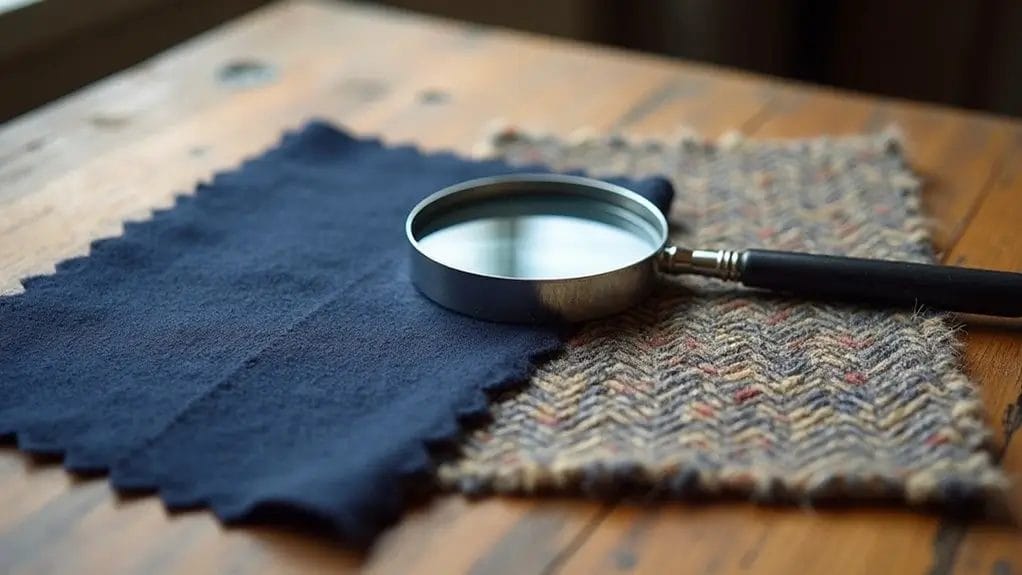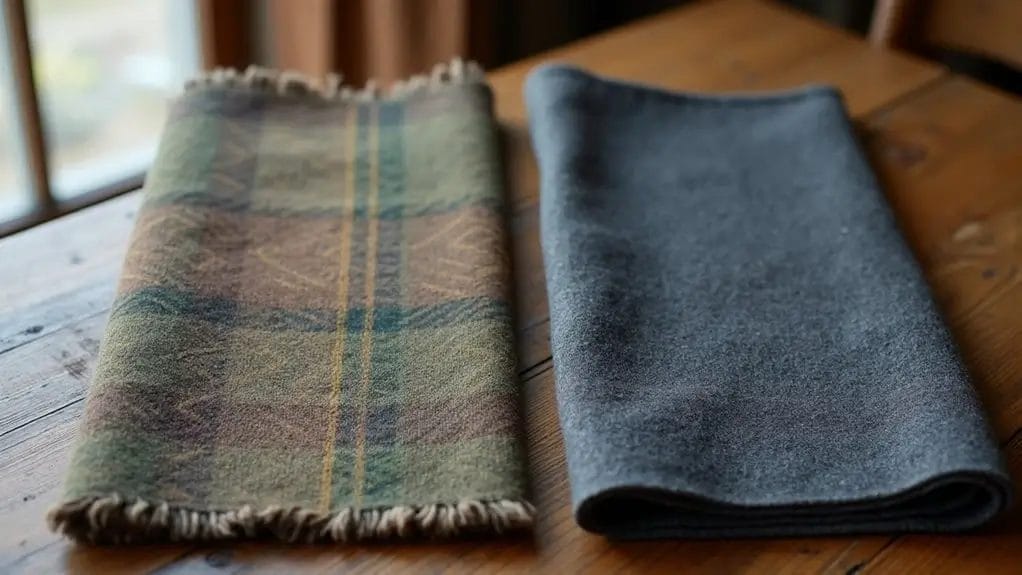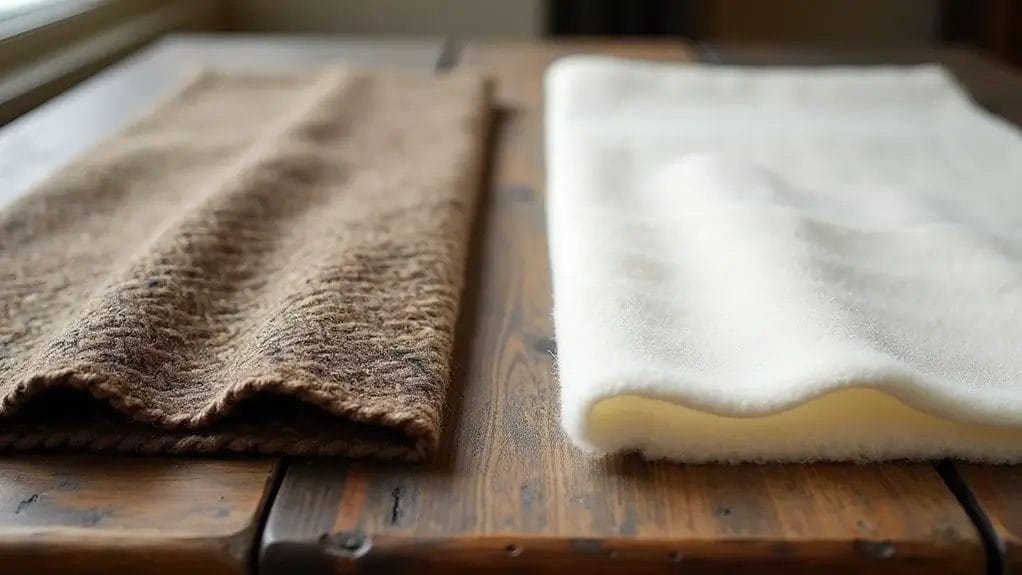When you're choosing between wool and tweed for your next garment, you'll need to understand that while they're related, they serve distinct purposes. Though wool forms the foundation of both fabrics, tweed represents a specific manufacturing process that transforms this natural fiber into something quite different. You'll find that each kind of material offers unique benefits and limitations, from thermal properties to durability. Let's examine these essential differences to help you make the right choice for your needs.
Key Takeaways
- Wool is a natural fiber from animals, while tweed is a woven wool fabric with distinctive patterns like herringbone or check.
- Pure wool offers better year-round versatility and temperature regulation, whereas tweed excels specifically in cold-weather protection.
- Tweed has a rougher, more textured appearance with visible patterns, while wool typically presents a smoother, softer surface.
- Wool garments can stretch up to 30% without losing shape, but tweed provides superior wind resistance and structural integrity.
- Wool suits everyday clothing needs like suits and sweaters, while tweed is traditionally used for outdoor wear and structured garments.
Understanding Wool: The Foundation Fabric

Wool is a natural protein fiber that you'll find primarily harvested from sheep, though it can also come from other animals like alpacas, goats, and rabbits.
You'll encounter several wool varieties in the textile market, including merino, cashmere, lambswool, and mohair, each offering distinct characteristics based on fiber diameter and length.
The fabric's inherent properties include excellent insulation, moisture-wicking capabilities, natural elasticity, and fire resistance, making it a versatile choice for various applications.
What is Wool?
Natural fibers harvested from sheep and other specialized mammals form the basis of wool, a remarkably versatile textile that's been integral to human civilization for millennia. This natural material consists of protein filaments that grow from specialized skin cells, creating a unique fiber structure.
- Each wool fiber contains microscopic scales that interlock, providing superior insulation
- The natural crimp in wool hair creates tiny air pockets, enhancing its thermal properties
- Wool fibers can absorb up to 30% of their weight in moisture without feeling wet
- The soft, elastic nature of wool allows it to return to its original shape after stretching
Wool's complex structure makes it both durable and comfortable, offering exceptional performance in various applications.
Types of Wool Fabrics
When exploring textile options, you'll find various wool fabrics that differ in weave patterns, fiber quality, and production methods. The main types include woolen and worsted wool, each offering distinct characteristics.
Woolen fabrics feature a looser weave with fibers pointing in multiple directions, creating a fuzzy texture and excellent insulation.
Worsted wool displays a smoother finish and higher quality, with fibers running parallel in the yarn.
You'll encounter lightweight merino wool, dense melton, and versatile gabardine among the popular varieties. Each type serves specific purposes, from fine suiting to heavy outerwear, with varying degrees of durability and comfort.
Key Properties of Wool
Understanding the core properties of wool begins with its unique molecular structure. The natural protein fibers make wool one of nature's most wear-resistant materials, with remarkable durability that you'll notice in quality garments.
- Crimped fibers create natural elasticity, allowing wool to stretch up to 30% without losing shape.
- Microscopic scales on each fiber make wool naturally water-repellent while remaining breathable.
- Natural insulation properties keep you warm in winter and cool in summer.
- As fibers break down over time, wool becomes softer without losing its structural integrity.
These properties combine to create a fabric that's both practical and long-lasting.
Exploring Tweed: The Patterned Wool

You'll find that tweed is a rugged, textured woolen fabric traditionally woven with multiple colored yarns in specific patterns to create distinctive visual effects.
The major varieties include Harris Tweed (protected by law and woven in Scotland's Outer Hebrides), Donegal tweed (featuring colorful slubs), Saxony tweed (made from merino wool), and Shetland tweed (produced from Shetland sheep wool).
The intricate weaving techniques used in tweed production encompass herringbone, check, barleycorn, and overcheck patterns, each contributing to the fabric's unique aesthetic and structural characteristics.
What is Tweed Fabric?
Tweed fabric stands as a distinct variant of wool characterized by its rugged texture and complex woven patterns. This traditionally wool-based fabric features intricate weave structures that create its signature appearance.
- Made primarily from wool fibers that undergo specialized spinning and weaving
- Features a variety of patterns including herringbone, check, and houndstooth designs
- Incorporates multiple colored yarns woven together to create depth and visual interest
- Maintains durability through tight weave construction and robust wool fibers
You'll find tweed's distinctive characteristics stem from its unique manufacturing process, where different colored yarns interweave to form subtle yet complex patterns.
This fabric's versatility makes it suitable for both traditional and contemporary applications.
Types of Tweed Fabrics
The diverse world of tweed fabrics encompasses several distinct varieties, each characterized by unique weaving patterns and regional origins.
You'll find Harris Tweed, a protected variety handwoven in Scotland's Outer Hebrides, known for its characteristic flecked appearance and medium weight.
Donegal tweed, originating from Ireland, features small, colorful slubs throughout the wool fabric.
Saxony tweed offers a softer, finer texture, while Shetland tweed provides a rougher, more traditional finish.
Estate tweeds display specific patterns and colors historically associated with Scottish estates and clans.
Each type serves different purposes, from formal wear to outdoor clothing.
Tweed Weaving Patterns
When examining traditional tweed weaving patterns, you'll discover a sophisticated array of distinctive designs that define this versatile fabric.
Different textile weaving techniques feature specific characteristics that create tweed's iconic appearance.
- Herringbone pattern showcases a distinctive V-shaped weave that creates a zigzag effect.
- Plain weave offers a simple over-under pattern that's fundamental to many types of tweed.
- Twill weave produces diagonal lines that give tweed its durability.
- Barleycorn pattern creates a small, textured surface resembling scattered grain.
These weaving patterns not only determine the fabric's appearance but also influence its performance, texture, and overall quality.
Key Differences: Tweed vs Wool

When examining the distinctions between wool and tweed, you'll notice key variations in their manufacturing processes, textures, and functional properties.
You'll find that wool serves as the raw material for tweed, but tweed undergoes additional weaving steps to create its characteristic patterns and robust structure.
Through careful analysis of these fabrics, you'll understand why wool is typically used for smoother, more versatile garments while tweed excels in structured outerwear and traditional countryside attire.
Manufacturing Process
Manufacturing processes for wool and tweed diverge markedly, despite both materials originating from sheep's wool. The process used to make each creates distinct characteristics and textures.
- Wool undergoes a straightforward process of cleaning, carding, and spinning into yarn that maintains its naturally soft feel.
- Tweed requires additional steps of blending different colored fibers and incorporating synthetic materials for durability.
- Traditional wool processing preserves the fiber's high elasticity and smooth texture.
- Tweed manufacturing intentionally creates a rough, textured surface through specific weaving patterns.
These fundamental differences in manufacturing ultimately determine how each fabric performs and feels in finished garments.
Texture and Appearance
The distinctive visual and tactile characteristics of wool and tweed fabrics create unmistakable contrasts in their final form.
You'll find pure wool clothing presents a smooth, refined texture with a subtle sheen, making it ideal for formal suits and polished fashion pieces. The color appears solid and consistent throughout.
In contrast, tweed's style showcases a characteristic rough, nubby texture with visible flecks and patterns woven into the fabric.
You'll notice its surface features small, raised bumps and a more rustic appearance. Tweed's multicolored yarns create depth through a complex interplay of different color combinations, resulting in its distinctive heathered look.
Functional Properties
Both wool and tweed fabrics offer distinct functional advantages that influence their practical applications.
You'll find their characteristics best suit different weather conditions and use cases:
- Pure wool is typically lighter and more versatile, making it suitable for year-round garments with excellent temperature regulation.
- Tweed's heavier construction provides superior wind resistance and durability, ideal for harsh winter conditions.
- Wool offers better moisture-wicking properties and natural water resistance, keeping you dry in variable weather.
- Tweed's dense weave creates additional insulation and structure, making it more suitable for outerwear and structured garments like jackets and coats.
Usage and Applications
Distinct functional properties of wool and tweed directly influence their traditional and modern applications in fashion and textile industries.
You'll find wool commonly used in various consumer products that need insulation and moisture control, such as fine suits, sweaters, and undergarments.
It's usually preferred for lightweight, year-round garments.
Tweed, often known for its durability and weather resistance, is traditionally used for outdoor wear like hunting jackets, overcoats, and sports blazers.
You'll typically find it in autumn/winter collections.
Modern applications include upholstery, accessories, and high-end casual wear where you need both style and performance.
Frequently Asked Questions
How Do You Properly Store Wool and Tweed Garments During Summer Months?
Store your wool and tweed garments in breathable garment bags, add cedar blocks to repel moths, keep them in a cool, dry place, and don't compress them. You'll want to clean them thoroughly before storage.
Can Wool and Tweed Fabrics Be Worn in Warm Climates?
You'll find lightweight wool and tweed blends suitable for warm weather. Choose tropical weight wool (7-9 oz) or summer tweed variants. They're breathable, moisture-wicking, and can regulate temperature effectively in milder conditions.
Are Wool and Tweed Fabrics Suitable for People With Sensitive Skin?
If you have sensitive skin, you'll need to be cautious with wool as it can cause irritation. However, you can opt for merino wool or softer tweed blends that are specifically processed for skin sensitivity.
What's the Average Lifespan of Wool Versus Tweed Garments?
You'll get 4-8 years from quality wool garments with proper care, while tweed typically lasts 6-10 years. Both can extend their lifespan considerably if you maintain them with regular cleaning and storage.
How Often Should Wool and Tweed Garments Be Professionally Cleaned?
You'll need to professionally clean wool garments once per season, while tweed should be cleaned annually. If you're not wearing them frequently, you can extend these intervals based on actual wear and soiling.
Conclusion
When you're selecting between wool and tweed, you'll need to evaluate their distinct characteristics and applications. While wool's versatile nature offers excellent insulation and moisture management for year-round wear, tweed's robust construction provides superior weather resistance and durability for outerwear. You'll find wool ideal for refined garments, whereas tweed's textured appearance and sturdy composition make it most suitable for structured, weather-resistant applications.


0 comments